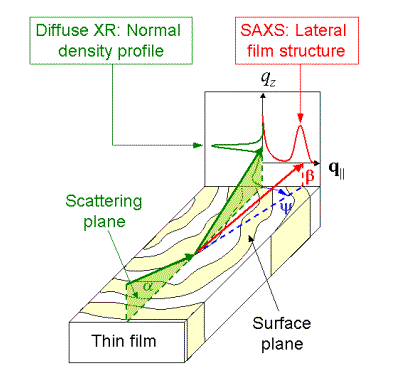
GISAXS
Detlef-M. Smilgies, CHESS G-line
Grazing-Incidence Small-Angle X-ray Scattering, short GISAXS, is a versatile tool for characterizing nanoscale density correlations and/or the shape of nanoscopic objects at surfaces, at buried interfaces, or in thin films. GISAXS combines features from Small-Angle X-ray Scattering (the mesoscopic length scale, incident beam definition by multiple slits, area detector) and diffuse X-ray Reflectivity (the scattering geometry and sample goniometer).

In order to make the x-rays surface sensitive, a grazing incidence angle
a
is chosen between about half the critical angle ac
and several critical angles. The actual choice depends on the system to
be studied. For free-standing quantum dots, an
incident angle below ac may be
chosen to make the scattering exclusively surface-sensitive. In order to
probe the internal structure of a thin film of 100 nm thickness, the incident
angle should be above ac of the film,
to ensure a full penetration of the sample [Smilgies].
The area detector records the scattering intensity of scattered rays over a range of exit angles b and in-plane scattering angles y. A beam stop has to be set-up to block spill-over direct beam as well as the reflected beam and the intense diffuse scattering in the scattering plane.
In the scattering plane the GISAXS intensity distribution corresponds
to a detector scan in Diffuse Reflectivity. The intensity distribution
parallel to the surface corresponds to SAXS. The full GISAXS intensity
map can be theoretically analyzed within the framework of Distorted-Wave
Born-Approximation [Rauscher].
Structure factor - lateral and normal density correlations
GISAXS provides information both about lateral and normal ordering of the interface or the thin film. This shall be illustrated with the example of lamellar films formed by symmetric polystyrene-polybutadiene block copolymers. In a block copolymer two inmiscible polymer chains are coupled with a chemical bond. If both chains occupy equal volumes, a lamellar phase is formed. In a thin film, i.e. if the thickness of the film is of the order of the lamellar period, the presence of two interfaces, air-film and film substrate, may induce some preferential order in the film as compared to the bulk polymer which forms a 3D powder of micron-sized lamellar domains:
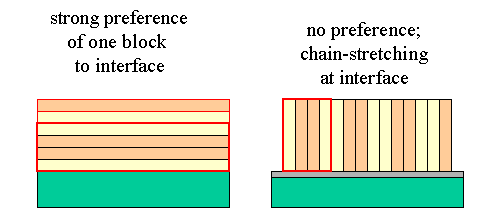
What kind of scattering will result from these two extreme cases ?
 |
If one of the blocks strongly favors one of the two interfaces, or even both, the lamellae will be parallel to the substrate. The classic example is PS-PMMA on a Si wafer covered with the native oxide [Anastasiadis]. The signature of parallel lamellae in GISAXS are stripes of intensity at regular spacings along the qz direction. |
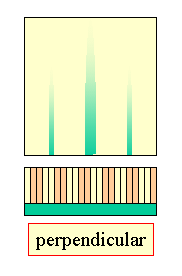 |
If both blocks have similar interface energies, chain stretching at the interface comes into play. Chain stretching occurs at the link between the inmiscible blocks of the polymer. A nematic ordering of this stretched part parallel to the interface may become favorable giving rise to the formation of perpendicular lamellae. As both interactions scale differently with the degree of polymerization [Pickett], there can be a transition from parallel lamellae to vertical lamellae, as we have found for PS-PB [Busch]. The signature of perpendicular lamellae are correlation peaks parallel to the interface, with a streaklike shape normal to the surface, similar to the scattering rods in Grazing-Incidence Diffraction [Als-Nielsen]. |
Note that perpendicular lamellae still have the freedom to change direction parallel to the surface - in fact AFM pictures [Busch] show that meandering lamellae are formed. Such a system is a 2D powder, similar to monolayers at the air-water interface [Als-Nielsen].
 |
Not always does the kinetics of the film formation allow a complete ordering of the films. Rings or partial rings in the intensity maps indicate anything from complete disorder of the lamellar domains to partial ordering, e.g. lamellae with a finite distribution of tilt angles with repect to the interface, respectively. |
Preferential lateral ordering and patterning
All examples discussed so far were all 2D powders, i.e. had rotational averaging with respect to the surface normal, resulting in a rotationally homogeneous scattering intensity. However, by patterning the substrate, further ordering may be imposed on the film, and perpendicular structures may show a preferential orientation with respect to the substrate as seen in polymer blends where the surface had been prepared by alternating hydrophobic and hydrophilic stripes [Boeltau].
Similarly, regular patterns can be prepared by lithographic techniques
[Woll]
representing an artificial lamellar system PMMA-air. In these cases the
GISAXS intensity distribution depends now also on the azimuth angle f
of
the substrate.
Form factor
Another type of scattering is observed for nano-objects with a narrow size distribution and well-defined shape. Here the form factor dominates the scattering, in particular, if the nano-objects are randomly placed on the surface. Examples are monodisperse nanoparticles absorbed on a surface [Du] or quantum dot arrays [Metzger]. Below the calculated scattering intensity from a dense layer of elliptical nanoparticles on a wafer surface is shown [Du] using the software package IsGISAXS [Lazzari]. The intensity oscillations in the qz direction are due to the formfactor of the ellipsoids.
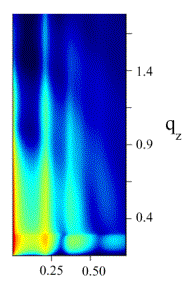
If further ordering occurs, such as well-defined nearest-neighbor distance at high densities, correlation peaks have to be taken into consideration. The highest degree of information on nanoparticles is obtained, if these have not only uniform shape, but also uniform orientation. The classic example are pyramid-shaped quantum dots on single crystalline surfaces [Metzger]. In the latter case the scattering intensity of a line scan taken parallel to the surface depends on the relative orientation of the pyramids to the beam as given by the azimuth angle f of the sample.
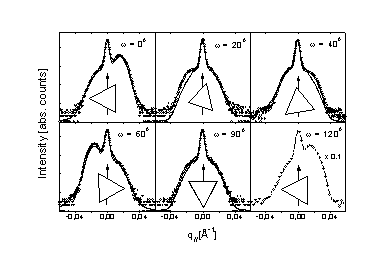
Summary
Mesoscopic systems can display a large range of ordering properties.
Each of these has a well-defined signature in its GISAXS intensity pattern.
Moreover, due to the penetration power of x-rays, not only surface structures,
but also the internal structure of thin films and buried interfaces can
be studied without any need of elaborate sample preparation, as needed
for instance for cross-section electron microscopy. Hard x-rays can penetrate
air, vapor, and small amounts of liquid allowing samples to be studied
in-situ and in real time [Smilgies].
All of these features make GISAXS a very versatile tool to study shape
and/or density correlations in nanoscopic systems.
References
| [Als-Nielsen] | J. Als-Nielsen and D. McMorrow: "Elements of modern X-ray physics", John Wiley & Sons, New York, 2001. |
| [Anastasiadis] | S. H. Anastasiadis, T. P. Russell, S. K. Satija, and C. F. Majkrzak: "Neutron reflectivity studies of the surface-induced ordering of diblock copolymer films", Phys. Rev. Lett. 62, 1852-1855 (1989) |
| [Böltau] | M. Böltau, S. Walheim, J. Mlynek, G. Krausch, U. Steiner, Nature 391, 877 (1998). |
| [Busch] | in preparation. |
| [Du] | Phong Du, Mingqi Li, Katsuji Douki, Xuefa Li, Carlos B.W. Garcia, Anurag Jain, Detlef- M. Smilgies, Lewis J. Fetters, Sol M. Gruner, Ulrich Wiesner, Christopher K. Ober: "Additive-driven Phase Selective Chemistry in Block Copolymer Thin Films: The Convergence of Top Down and Bottoms Up Processing", submitted. |
| [Lazzari] | R. Lazzari, J. Appl. Cryst. 35, 406-421 (2002). |
| [Metzger] | T. H. Metzger, I. Kegel, R. Paniago, A. Lorke, J. Peisl, J. Schulze, I. Eisele, P. Schittenhelm, and G. Abstreiter: "Shape, size, strain and correlations in quantum dot systems studied by grazing incidence X-ray scattering methods", Thin Solid Films, 336(8),1-8, (1998). |
| [Pickett] | G. Pickett, T. Witten, S. Nagel, Macromolecules 26, 3194 (1993). |
| [Rauscher] | M. Rauscher, T. Salditt, and H. Spohn: "Small-angle X-ray scattering under grazing incidence: the cross section in the distorded-wave Born approximation", Phys. Rev. B, 52(23), 16855-16863, (1995). |
| [Russell] | S. H. Anastasiadis, T. P. Russell, S. K. Satija, C. F. Majkrzak, J. Chem. Phys. 92, 5677 (1990). |
| [Smilgies] | Detlef-M. Smilgies, Peter Busch, Dorthe Posselt, and Christine M. Papadakis: "Characterization of Polymer Thin Films with Small-Angle X-ray Scattering under Grazing Incidence (GISAXS)", Synchrotron Radiation News, Issue 15(5), 2002. (preprint) |
| [Woll] | unpublished. (follow the link to see a pretty picture) |